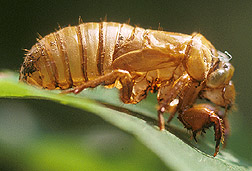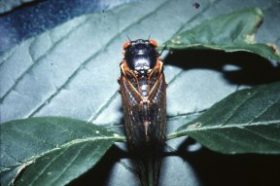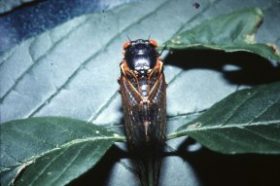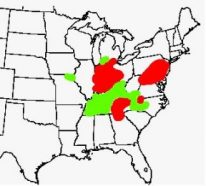Prime time for cicadas
Researchers are tracking down why some types of cicadas emerge in vast numbers only once every 17 years.
By Emily Sohn
If it hasn’t happened yet, it could occur any day now.
The first signs are little holes in the ground in yards, orchards, and fields. Then, one warm evening, big, red-eyed bugs start crawling out of the holes.
The next morning, thousands upon thousands of these black, winged insects, known as cicadas, cover sidewalks, mailboxes, tree branches, and roofs across certain areas of the United States. The loud throb of their alien-sounding, high-pitched screeches fills the air.
For the first time in 17 years, such a cicada onslaught is due to hit Washington, D.C., Baltimore, Long Island, Cincinnati, Detroit, and other parts of the Northeast and Midwest.
 |
|
After spending 17 years underground, cicadas are set to emerge in parts of the United States.
|
| Alex Jeon, National Science Foundation |
If you don’t like bugs, watch out. For anyone who lives in the invasion area, the cicadas will be impossible to ignore, says David Marshall. He’s an evolutionary biologist and cicada expert at the University of Connecticut in Storrs.
And, if you’re caught by surprise, the experience can be pretty overwhelming. Some people find it downright creepy.
Puzzling cycles
Even if you don’t get to witness the great cicada awakening, it’s worth pondering the phenomenon. Despite years of research, the life cycles and habits of cicadas still present puzzles to modern science.
Researchers are especially interested in the types of cicadas that will be swarming over the eastern United States this spring. Called periodical cicadas, these insects live only in this part of the world, and they appear just once every 17 years, on the dot. Related periodical cicadas have a precise 13-year cycle. Other species, known as annual cicadas, make an appearance every year.
“This is a really special phenomenon that doesn’t happen anywhere else in the world,” Marshall says.
All cicada eggs hatch into juveniles underground, where they go through five stages of development before emerging as adults, mating, and starting the cycle all over again. Adult periodical cicadas are about 1.5 inches long. They can neither bite nor sting.
 |
|
Cicada nymph.
|
| U.S. Department of Agriculture, Agricultural Research Service |
On average, a population of annual cicadas spends between 2 and 8 years underground before facing the light of day. Different populations stagger their maturation, though, so that a small number hatch each year. They usually appear in the summertime. You might see just a handful in your neighborhood every year.
Annual cicadas use strategies such as speed or camouflage to avoid the hungry mouths of birds, squirrels, cats, fish, and other predators.
Periodical cicadas, on the other hand, come out in the spring, and they use each other for protection, Marshall says. “When they come out in such great numbers, the risk to any individual cicada being eaten by a predator goes down,” he says.
In fact, periodical cicadas are so indifferent to predators that you can walk right up to them and grab a handful. Most of the time, they don’t even try to fly away.
Prime time
One big mystery is why periodical cicadas wait such a long time and a particular number of years before emerging. The answer, some scientists now suggest, appears to involve weather and mathematics.
 |
|
Adult cicada.
|
| Ohio Department of Natural Resources, West Virginia Department of Agriculture |
Periodical cicadas belong to a genus called Magicicada, which first appeared sometime around 1.8 million years ago. Back then, glaciers covered the land, and the climate of eastern North America was unpredictable. Sometimes summers were warm. Sometimes they were cold.
Juvenile Magicicada won’t even crawl out of the earth until the soil reaches 64 degrees F., Marshall says. After that, they need consistently warm temperatures, usually above 68 degrees F., to survive.
By evolving to stay underground as long as possible, some experts say, cicadas reduced their chances of emerging during a particularly cold summer.
In one study, researchers from Tennessee and Arkansas looked at what would happen if there were one dangerously cold summer every 50 years for 1,500 years. Their mathematical model showed that cicadas with a life cycle of 7 years had only an 8-percent chance of surviving. With an 11-year cycle, survival jumped to 51 percent. At 17 years, cicadas had a 96-percent chance of living.
So, staying underground longer is better. In fact, periodical cicadas live longer than almost any other insect.
Multiple breeding
Why do periodical cicadas live precisely 13 or 17 years?
Both 13 and 17 belong to a special class of numbers called primes. This means that the numbers can be evenly divided only by themselves or the number 1. The first few prime numbers are 2, 3, 5, 7, 11, 13, 17, and 19.
Mathematicians spend a lot of time trying to understand prime numbers. Cicadas somehow understand primes instinctively. What’s more, the insects seem to know how to count.
The fact that 17 and 13 are primes reduces the chances of interbreeding among different populations of 17- and 13-year cicadas, Marshall says.
Multiples of prime numbers are unlikely to overlap with multiples of other prime numbers. So, a cicada population that hatches every 2 or 5 or 7 years will hardly ever hatch at the same time as a population that hatches every 13 or 17 years. And the 13- and 17-year cicadas will emerge at the same time only once every 221 years.
 |
|
Two cicadas mate during their brief time above ground.
|
|
© Chris Simon, University of Connecticut
|
If populations don’t hatch at the same time, they can’t mate with each other, so their genes remain distinct. That’s important because genes help determine the length of the insect’s life cycle. If a 5-year cicada were to mate with a 17-year cicada, for example, the length of the cycle would be different every generation. The 17-year cicadas would immediately lose their timing advantage.
To understand the process better, scientists recently crossed a 13-year species with a 17-year species. They’re curious to see whether the offspring hatch after 13 years, 17 years, or somewhere in between. Now, it’s a matter of waiting for the results—which will take years to get.
The answer should help explain which genes control cicada development. “I honestly don’t know what’s going to happen,” Marshall says.
The results might also help explain how cicadas know when 17 or 13 years have passed. Some experiments suggest that the insects actually count years while they wait underground.
Cicadas may also respond to cues in the environment.
The trees that cicadas feed on produce flowers every year. When scientists from the University of California, Davis transplanted juvenile cicadas onto potted trees and forced the trees to flower twice in one year, the cicadas hatched a year early.
Quick evolution
If all of this puzzles you, you’re not alone. Scientists have lots of questions, too. “It’s so difficult to explain this kind of thing,” Marshall says. “It’s such a remarkably complex species.”
It’s these complexities that attracted Marshall to cicadas in the first place. Marshall studies speciation, the process of forming new species. Cicadas are turning out to be a great model for learning about evolution.
Just a few years ago, Marshall was part of a research team that discovered an unexpected seventh species of periodical cicadas in Missouri, Illinois, and northern Arkansas. The first clue was a slight difference in the pitch of the insect’s song compared with that of a nearby species.
When Marshall and his colleagues turned to genetic evidence, they discovered that the new species had evolved just 10,000 years ago. That’s remarkably recent in the grand scheme of evolution. It’s almost like watching speciation happen in real time.
Elsewhere, researchers at Princeton University are planning to track cicadas with tiny radio transmitters that weigh less than a gram.
Understanding how cicadas move around will give further insights into the process of speciation and evolution, Marshall says.
Learning more
If you want to know more about cicada invasions, talk to someone who was around 17 years ago. Or look up 17-year-old newspapers from the affected region in your local library. Chances are, you’ll find articles about cicadas.
 |
|
The red and green areas show where in the United States that 17-year cicadas are set to emerge this year.
|
|
University of Michigan Museum of Zoology
|
You’ll also get a better idea of when to expect their arrival—if they haven’t arrived already! Cicadas emerge later in colder places. Washington, D.C., for example, may see them around May 14. Near Detroit, they probably won’t appear until early June.
Most of the stories you hear will probably be full of wonder and admiration for the unique creatures. Their large size makes them spectacular. Their rarity makes them special. As a bonus, they’re totally harmless. Some people even eat them!
Whether or not you choose to chew your cicadas, it makes sense to swallow any creepy-crawly feelings that you might have and appreciate the insects now. After all, you won’t get another chance for a long, long time.







